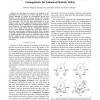Free Online Productivity Tools
i2Speak
i2Symbol
i2OCR
iTex2Img
iWeb2Print
iWeb2Shot
i2Type
iPdf2Split
iPdf2Merge
i2Bopomofo
i2Arabic
i2Style
i2Image
i2PDF
iLatex2Rtf
Sci2ools
ICRA
2007
IEEE
2007
IEEE
A Comparative Dependability Analysis of Antagonistic Actuation Arrangements for Enhanced Robotic Safety
Abstract— In this paper we introduce an analysis of dependability of an elementary yet critical component of robotic systems designed to operate in environments shared with humans, i.e. the joint-level actuation system. We consider robot joints that implement the Variable Impedance Actuation (VIA) paradigm. The VIA has been demonstrated to be an effective mean to achieve high performance while constantly keeping injury risks to humans by accidental impacts below a given threshold. The paper describe possible implementations of the VIA concept which use the Antagonistic Actuation (AA) in three different arrangements. This study follows a previously reported paper dealing with safety. Here a detailed comparative dependability and performability analysis in front of possible specific failure modes is conducted, whose results provide additional and useful guidelines for design of safe and dependable actuation systems for physical human-robot interaction.
Actuation Systems | ICRA 2007 | Joint-level Actuation System | Robotics | Variable Impedance Actuation |
| Added | 03 Jun 2010 |
| Updated | 03 Jun 2010 |
| Type | Conference |
| Year | 2007 |
| Where | ICRA |
| Authors | Roberto Filippini, Soumen Sen, Giovanni Tonietti, Antonio Bicchi |
Comments (0)

